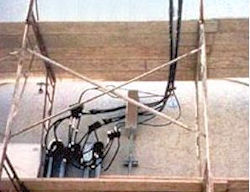Power Lines
Working around high voltage (HV) power lines can be extremely dangerous. As work is being completed, it's easy to forget the HV lines are overhead.
Make sure you know the voltage of energized power lines and ensure everyone is aware of the location of energized power lines. They may work near power lines only under the supervision and direction of a competent person qualified in scaffold erection, moving, dismantling or alteration. Also, erection, moving, and dismantling activities must be performed only by experienced and trained employees selected by a competent person.
Scaffolds must not be erected, used, dismantled, altered, or moved such that they or any conductive material handled on them might come closer to exposed and energized power lines.
For insulated lines of less than 300 volts, the minimum clearance distance is 3 feet and for uninsulated lines, the minimum distance is 10 feet. For more information on clearance distances, see the table in 1926.451(f)(6), Minimum Distance From Power Lines (Open the table to the right).
However, according to 29 CFR 1926.451(f)(6), scaffolds and materials may be closer to power lines than specified in the table where:
- such clearance is necessary to perform the work,
- the utility company, or electrical system operator, has been notified of the need to work closer, and
- the utility company, or electrical system operator, has deenergized the lines, relocated the lines, or installed protective coverings to prevent accidental contact with the lines.
Knowledge Check Choose the best answer for the question.
1-4. How far should scaffolding be from a 300 volt uninsulated power line?
You forgot to answer the question!


